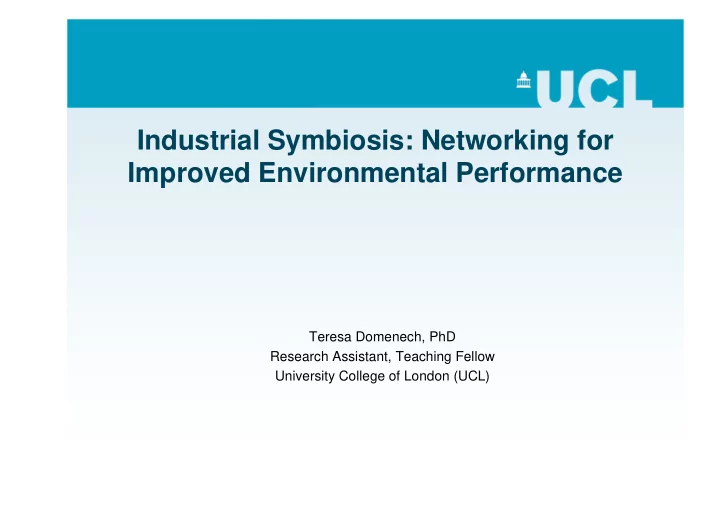

Industrial Symbiosis: Networking for Improved Environmental Performance Teresa Domenech, PhD Research Assistant, Teaching Fellow University College of London (UCL)
From a linear to a circular industrial system • From linear… Natural virgin Waste Production Resources system • To cycling… Natural virgin Byproducts Production Residual Resources system waste Recycling
Defining industrial ecology “It is a system view in which one seeks to optimize the total materials cycle from virgin material, to finished material, to component, to product, to obsolete product and to ultimate disposal” by emulating the efficient functioning of natural ecosystems, where “effluents and waste from one process serve as the input materials for other processes or are recycled for further production”. (Graedel, 1996-Gibbs, 2003)
The Ecological Metaphor
Dimension of Industrial ecology (Chertow, 2001) Within a company Intercompany level Material cycles • Improvement of • Exchange of • Analysis of the eco-efficiency waste flow material cycles of between different different • Reuse and processes and substances and recycle of activities components at materials the whole • Recycle from • Cascading of economy level waste materials water and energy and use as input materials • Cascading of water and energy
Industrial symbiosis networks • Industrial symbiosis focuses on the cooperative relationship between industries to reduce the material and energy “loses” of the industrial system as a whole by promoting the exchange of by-products and “wastes” • Two main approaches: � Eco-industrial parks - Spatial-centred approach � Eco-industrial networks (virtual eco-industrial parks) – Information-centred approach
WHY APPLYING SNA TO IS NETWORKS? • Identify key actors in the operation of the networks • Determine what networks structure may provide better outcomes • Local bridges • Network position, trust and power/ influence • Identify structural characteristics that may foster or limit the efficient operation of the network • Determine potential patterns of development of IS networks • Identify potential risks of disconnection of the network
Social Network Theory • Two levels of analysis: – Complete network – Ego-centered network • Dyads and nodes • Core/periphery structure • Centrality • Connectedness • Geodesic distance
Social Network Theory: Analysis of industrial symbiosis networks External • Size Structural • Local bridges characteristics • Core/ Periphery Internal • Density • Openness /closeness • Centrality • Stability Transactional • Exchange of information and characteristics knowledge • Exchange of influence and power • Exchange of materials and energy • Intensity Nature of the links • Frequency • Reciprocity • Multiplexity
Industrial symbiosis networks: Conditions of emergence Structural Exchange Conditions Social Mechanisms of control Embeddedness • Stringent and rapidly • Collective sanctions evolving regulatory • Reputation framework • Macroculture of • Shortage of raw cooperation materials • The need of customised, ad-hoc solutions • Frequent interaction
Case study: kalundborg (Denmark)
Whole network structure
Energy network
Material network
Knowledge network
Structural characteristics Whole network Materials Water network Energy Knowledge network network network Number of 22 9 14 6 44 ties Density 0.2 0.0818 0.1556 0.0667 0.4889 Network 57.78% 18.89% 33.33% 52.78% 33.33% centalisatio n Ave. 1.585 1.000 1.125 1.143 1.214 Geodistanc e Distance- 0.279 0.082 0.167 0.072 0.556 based cohesion “compactn ess” Distance- 0.721 0.918 0.833 0.928 0.444 weighted fragmentati on “breath” Mean Std Mean Std Mean Std Mean Std Mean Std Dev Dev Dev Dev Dev Degree 3.273 2.178 1.455 0.782 1.600 1.685 1.200 1.400 4.600 2.615 centrality Betweennes 2.182 3.0777 0.000 0.000 0.200 0.400 0.100 0.300 1.200 2.400 s centrality 999 Closeness centrality IN 13.407 0.889 9.871 0.713 12.312 2.376 10.788 0.733 23.955 4.737 OUT 29.515 27.922 9.933 1.113 12.606 3.193 11.544 4.273 34.974 16.374
Centrality CENTRALITY Degree Betweenness Closeness NODES IN OUT Asnaes power 8.000 8.667 12.346 83.333 station Novozymes 5.000 1.667 12.500 47.619 Novo Nordisk 5.000 7.667 12.500 66.667 Statoil refinery 5.000 2.000 12.346 62.500 Municipality 4.000 4.000 14.085 10.000 Component 2.000 0.000 13.699 9.091 recyclers Gyproc 2.000 0.000 13.699 9.091 Farmers 2.000 0.000 13.889 9.091 Fish Farm 1.000 0.000 13.514 9.091 Cement 1.000 0.000 13.514 9.091 companies Soilrem 1.000 0.000 15.385 9.091
Main Findings: characteristics of successful networks • The core is dense and well articulated, favouring the interaction between the members. This morphology favours the rapidly dissemination of ideas and information. • Due to the small size of the network, the path distance is very small, which has contributed to a) reduce the transaction costs associated with the exchanges b) favour the building of trust and commitment among members. • Multiplexity of the linkages contributes to increase the density of the network and favours the building of stronger relationships, which could indeed explain the innovation capacity of the network. • The analysis of the centrality measures point to small number of key players of the networks: central actors are important not only for the number of direct connections they hold with other members of the networks, but also for its capacity to connect other nodes, and therefore, to ensure the cohesion of the network. Hence, the disconnection of any of these nodes will cause an important disturbance to the operation of the network, which could lead to defragmentation.
THANKS FOR YOUR ATTENTION Contact details: t.domenech@ucl.ac.uk
Recommend
More recommend